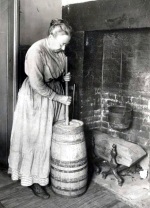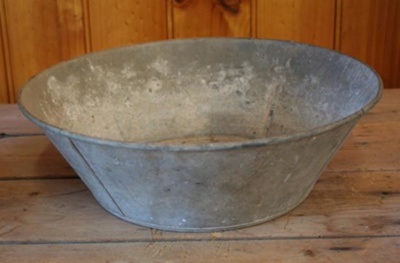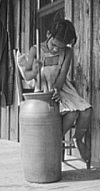Thoughts on a Thursday

The thoughts today are about Butter Churns
My husband collects these in different sizes.
Home butter-making took time and energy, but only needed simple equipment. Low-tech methods were still well-known in rural parts of developed countries like the USA in the mid-20th century. In the UK it became less common for ordinary families to make their own butter in the course of the 19th century, but the old ways were still used on small farms and in the dairies belonging to grand houses.
After the cow(s) were milked, the milk was left to settle in a cool place, in shallow dishes, also called setting dishes or pancheons, so the cream would rise to the top. (Unless the butter was to be made from whole milk: less common than making it from cream.) Brass and earthenware dishes were used in the UK in the 17th and 18th centuries, with earthenware becoming gradually more popular, as brass sometimes tainted the flavour.

After half a day or so, the cream was skimmed off and put ready for the churn. Small home producers would want to collect a few days of milking to have enough cream to be worth churning, and a little fermentation would "ripen" the flavour. But the cream couldn't be left waiting too long in summer-time.
Cream-skimmers were used to lift off the cream. These worked well if they were shallow with a thin, almost sharp, edge. Skimmers from the last couple of centuries were often saucer-shaped with perforations to catch the cream while letting milk drip back into the pan, just like those used to remove surface "scum" from stock. Brass cream-skimmers on long or short handles are decorative antiques now, but some were much simpler. Anything the right shape would serve the purpose, like this wooden skimmer made to an older design. Other names for these were fleeter, scummer, skimming spoon, skimming ladle.
Churning
Moving the cream constantly is the churning that actually produces butter by separating out the yellow fat from the buttermilk. Simply shaking it in a closed jamjar for an hour or so will work, or you can swing unseparated milk in an animal skin hung on sticks, an ancient method still used in some parts of the world.

A stick called a dasher or churn dash was moved up and down by hand in an upright container, usually made of wood or earthenware, as in the first two pictures on this page. A churn lid from 1400 years ago, with a hole for the stick, shows that this method has a long history. The stick might be perforated, or it could have a wooden circle, or crossed boards attached, but even with those to help beat the cream, this method took longer than using the more complex kinds of churn which were introduced in the 18th century, and became popular in the 19th.

Churn Lid
The long job had its own rhyme. This was sometimes thought of as a charm to make the cream turn into butter, and sometimes as a song which went with the rhythm of the work. It was widely known on both sides of the Atlantic, with many variations, and was probably already old when mentioned in print in 1685. Many cultures had their own churning songs. Some had other charms and superstitions too. Both in Europe and North America metal objects - like needles, knives or horseshoes - were used to drive away evil influences which might prevent cream from turning to butter.
*************************
Most of this information came from old and interesting things and more info is found here
http://www.oldandinteresting.com/butter-crocks-history.aspx#more
I made butter in a jar with whipping cream when I was teaching Sunday School. We would often make honey cakes and eat them with the butter we made. Yum!
~~~~~~~~~~~~~~~~~~~~~~~~
######################

We have record of its use as early as 2,000 years before Christ. The Bible is interspersed with references to butter, the product of milk from the cow. Not only has it been regarded from time immemorial as a food fit for the gods, but its use appears to have been divinely recommended and its users promised certain immunities against evil. Butter was the only food ever defined by an Act of the U.S. Congress prior to the enactment of the Food, Drug and Cosmetic Act of 1938.
The word butter comes from bou-tyron, which seems to mean "cowcheese" in Greek. Some scholars think, however, that the word was borrowed from the language of the northern and butterophagous Scythians, who herded cattle; Greeks lived mostly from sheep and goats whose milk, which they consumed mainly as cheese, was relatively low in butter (or butyric) fat.
For more on this story
http://www.webexhibits.org/butter/history-intro.html
########################
Just a reminder that I now have many things listed in my Etsy Store at'
This Friday is Open Studio (formerly Retts day) 10-4
and next week on Thursday the 19th is our Maggie B class 10-4
Wisdom for today
Thanks for stopping by. Betty



Comments
Post a Comment